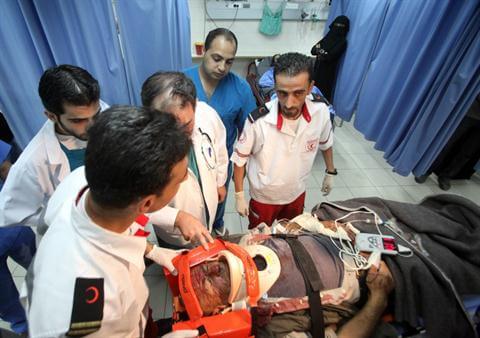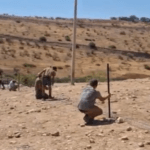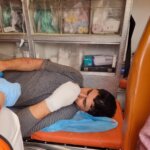Settler violence in Bi’r El Eid – South Hebron Hills
 Bir El Eid is a small village in the South Hebron Hills, in Area C. This means it is under the administration of the Israeli Occupation Forces. Because of this, if residents want to build, they must seek permission from the Israeli authorities. But the likelihood of receiving a permit is so low that residents are forced to build structures without one, which exposes their homes to constant threat of demolition. For example, on June 20, 2011, the whole village was destroyed, with tents demolished, electrical wires cut and vegetables uprooted.[i] Bir El Eid is surrounded by settlements on all sides, whose residents are particularly violent and aggressive.
Bir El Eid is a small village in the South Hebron Hills, in Area C. This means it is under the administration of the Israeli Occupation Forces. Because of this, if residents want to build, they must seek permission from the Israeli authorities. But the likelihood of receiving a permit is so low that residents are forced to build structures without one, which exposes their homes to constant threat of demolition. For example, on June 20, 2011, the whole village was destroyed, with tents demolished, electrical wires cut and vegetables uprooted.[i] Bir El Eid is surrounded by settlements on all sides, whose residents are particularly violent and aggressive.
Residents also have limited access to water, with water cisterns located near the outpost of Mitzpe Yair, and attempts to bring water from the cisterns have been met with settler and army harassment, even with the army confronting villagers with tear gas.
In 1999, the army declared Bir El Id a firing zone and residents were forced to leave their homes. At the beginning of 2000, the court decided that residents were allowed to return to their village, but they left again due to settler violence. At the end of 2009, people started to return to their homes and remain there to date.
A Jordan Valley Solidarity volunteer visited this village on 16th December 2012 with the group EAPPI, who were interviewing Ismail Adara, a resident of Bir El Eid. He recounted a number of incidences involving both the army and settlers which were clearly an attempt to push these villagers off their land, in an act of ethnic cleansing. Settlers in the area are very violent, many of whom have been named by villagers, such as Yaakov, Avidan and Ilad, but no action has followed this naming and no process of accountability has been put in place.
The settler, Yaakov, lives on a settlement farm alone with his family, has been consistently abusive and threatening towards villagers and is claiming that the land of villages in the area belongs to him. His reasoning is that the villagers were absent for a period of time since the year 2000. The army frequently takes action for Yaakov’s benefit, such as raiding the village, demanding the return of sheep the villagers allegedly stole. The army took a number of sheep, who promptly escaped and returned to the village, wishing to be reunited with their babies. The sheep clearly did not belong to Yaakov.
Four days before the interview, at 12.30am in the night, Ismail was sleeping when he heard strange noises. He got up quickly, ran outside and realized two men had been throwing stones at his tent. He pursued them, yelling after them and then saw another three men awaiting the two men up the hill. Ismail realised they were soldiers. Ismail asked why they had been throwing stones at his home, but they denied responsibility, claiming the perpetrators must have run elsewhere. These psychological games, employed to terrorise people, are part of Israeli strategy to displace people from their homes, in an act of ethnic cleansing.
But psychological torment often turns into direct physical assault and abuse, as Ismail explained. He spoke about a violent incident between himself and some settlers from the outpost Mizpe Yair which occurred in August of this year. Ismail explains that as an old man, he does not expect to be the victim of such. However, one day, when he was tending to his land with a rake, four settlers (two of whom he recognized as Avidan and Ilad) approached him. The settlers attempted to wrestle his rake from him, but Ismail refused to let go. Infuriated by his defiance, another settler pulled a gun on him, but Ismail managed to reason with the settlers and they left. Ismail knew that this was not the last he would see of these men.
Fifteen days following the initial assault, the settlers returned as Ismail was tending his land again, this time with scarves over their faces. Ismail could see Avidan and Ilad waiting in the car, ready to drive away if other Palestinians were around. One settler approached Ismail quickly, as if to greet him, but instead head butted him in the face. Ismail used the plastic pipe in his hand (used for the sheep) to defend himself by hitting the settler with it. The settlers had long, wooden sticks and began to beat Ismail with them. Then, one settler pulled out a knife, attempting to stab Ismail, but sliced off his finger instead (at this point, Ismail shows us his impressive, new finger). The settlers continued to beat Ismail, hitting him on either side of his head and then kicking him when he is on the ground. Some people saw what was happening, called the army, and took Ismail to Alia hospital in Hebron where he is treated. The army asked who beat him and he told them the names of these settlers, but neither was held accountable for their actions.
Many parallels can be drawn between the situation in the Jordan Valley and South Hebron Hills, such as water scarcity, unemployment and poverty, as well as settler violence – all of which are strategies employed by Israel to pressure Palestinians off their land with the intention of annexing the areas. For residents in both areas, existence is resistance, and they will not leave their land.
The attach on Ismail by settlers was previously reported by the Daily Star: http://www.dailystar.com.lb/News/Middle-East/2012/Aug-27/185844-palestinian-shepherd-wounded-by-settlers.ashx#axzz2FNGQsG9r





